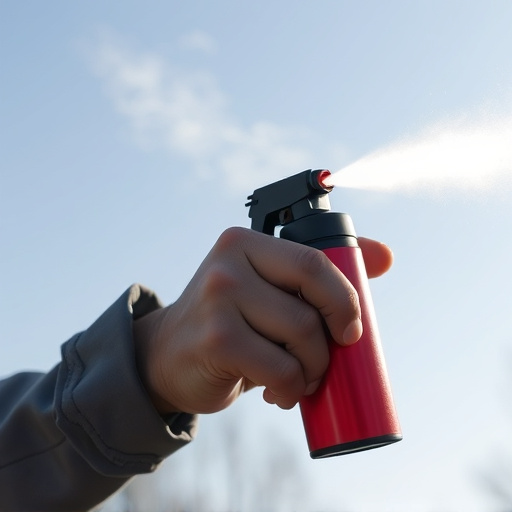Understanding the risks of pepper spray use is crucial. Chemical burns from pepper spray require immediate action: move to a ventilated area, remove contaminated clothing, and flush eyes with water for 15 minutes. Treating burns involves gentle cleaning, cold compresses, and medical attention if irritation persists. Proper handling, training, and knowledge of local laws are essential for safe use of defensive spray.
Defensive spray has become a popular tool for civilian self-defense, offering a non-lethal means of protecting against potential threats. However, understanding its effects and risks is crucial before considering it as an option. This article delves into the world of pepper spray, exploring common causes of chemical burn injuries and providing guidance on treating exposure at home. We also navigate the legal considerations surrounding civilian self-defense sprays, ensuring you’re informed about your rights and responsibilities.
- Understanding Pepper Spray: Effects and Risks
- Common Causes of Chemical Burn Injuries
- Treating Pepper Spray Exposure at Home
- Legal Considerations for Civilian Self-Defense Spray
Understanding Pepper Spray: Effects and Risks
Pepper spray, a common self-defense tool for civilians, is designed to incapacitate an attacker temporarily. It contains capsaicin, the same chemical that makes chili peppers spicy. When sprayed into the eyes and respiratory system, pepper spray causes intense irritation, leading to tears, coughing, and difficulty breathing. While effective as a deterrent, it’s crucial to understand the potential risks and effects.
Treating Pepper Spray Chemical Burns is an important consideration after exposure. The affected area may experience severe burning sensations, redness, and pain. In some cases, blisters can form within 24-48 hours. Seeking medical attention promptly is recommended, especially for individuals with pre-existing respiratory conditions or sensitive skin. Proper decontamination techniques, such as rinsing eyes thoroughly with water for at least 15 minutes, can help alleviate symptoms and prevent complications.
Common Causes of Chemical Burn Injuries
Chemical burn injuries from pepper spray are a significant concern for civilians who find themselves in potentially dangerous situations. These burns can result from direct contact with the eyes, skin, or respiratory tract, causing severe discomfort and even long-term damage. Understanding common causes is essential in learning how to treat these types of injuries effectively.
One of the primary reasons for chemical burn injuries is overuse or misuse of pepper spray during self-defense situations. When sprayed into the face, the capsaicin, a main ingredient, can lead to significant eye and skin irritation. Inhaling pepper spray can also result in respiratory distress. Treating these burns involves thorough irrigation with water, neutralizing any residual chemical exposure, and applying topical remedies to soothe and heal affected areas, especially when focusing on treating pepper spray chemical burns.
Treating Pepper Spray Exposure at Home
In the event of accidental exposure to pepper spray, whether at home or elsewhere, immediate and proper treatment is crucial. If a person experiences irritation or burning sensations after coming into contact with pepper spray, they should immediately move to a well-ventilated area to prevent further inhalation. Removing any contaminated clothing or footwear carefully, while avoiding rubbing the affected skin, can help minimize direct contact with the chemical.
Treating Pepper Spray Chemical Burns involves applying cool water to the affected areas for at least 15 minutes. This helps dilute and wash away the pepper spray residue. Using a mild soap and clean cloth to gently clean the skin is also recommended. If irritation persists or deepens, seeking medical attention becomes essential. Applying a cold compress or ice pack wrapped in a thin towel can provide additional relief from swelling and pain while the affected area heals.
Legal Considerations for Civilian Self-Defense Spray
When considering defensive spray for civilian protection, it’s crucial to understand the legal considerations that come into play. The use of self-defense spray is regulated by state laws, and what is permitted varies significantly across different regions. In many places, civilians can legally carry and use pepper spray for self-defense if they meet certain criteria, such as completing a training course or having a concealed weapons permit. However, there are strict rules regarding the type of spray allowed, its strength, and where it can be carried.
Treating pepper spray chemical burns is also an important consideration. If used improperly or without adequate training, pepper spray can cause significant harm, including chemical burns to the skin and eyes. It’s essential for users to understand de-escalation techniques and safe application methods to minimize the risk of injury. In case of exposure, immediate flushing with water for at least 15 minutes is recommended, followed by seeking medical attention if needed. Understanding local laws and properly handling defensive spray are vital steps in ensuring civilian safety during self-defense situations.
Defensive spray has emerged as a powerful tool for civilians seeking self-protection. By understanding the effects and risks of pepper spray, recognizing common causes of chemical burn injuries, and knowing legal considerations, individuals can make informed decisions about its use. Additionally, being equipped with home treatment options for pepper spray exposure allows for immediate care and comfort. Remember, while defensive spray can be a game-changer in dangerous situations, responsible usage and proper aftercare are paramount to minimizing potential health risks associated with these powerful substances.
